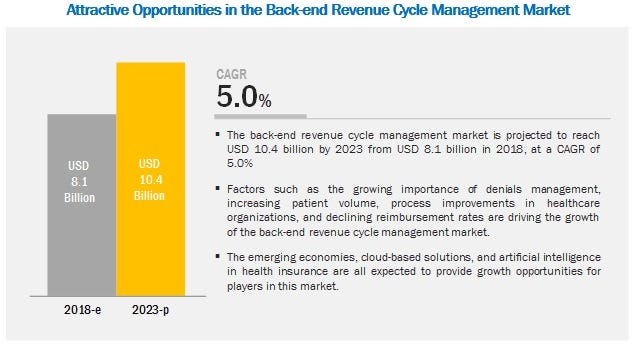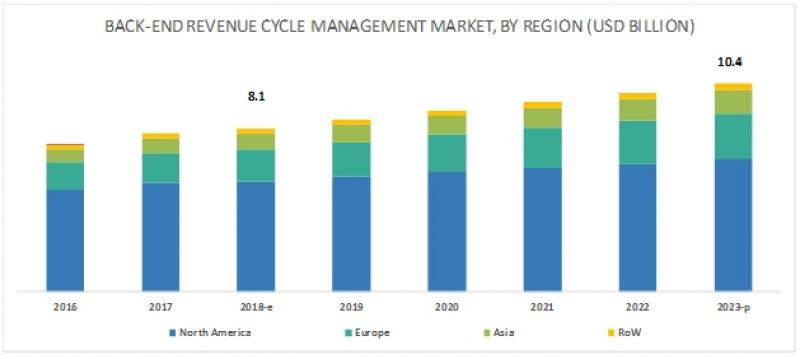New report examines the Back-end Revenue Cycle Management Market forecast to 2023
Factors such as the growing importance of denials management, increasing patient volume, process improvements in healthcare organizations, and declining reimbursement rates are driving the growth of the back-end revenue cycle management market.
Also, growth opportunities in emerging markets, cloud-based solutions, artificial intelligence in health insurance, and rising adoptions of EHR’s may act as an important boosting factor for the exponential growth of back-end revenue cycle management market.
On the other hand, the high cost of deployment, integration of back-end revenue cycle management solutions, data breaches and loss of confidentiality, and lack of skilled IT professionals in healthcare are the key factors that are expected to restrain market growth to a certain extent during the forecast year.

Download PDF (Back-end RCM Market):
https://www.marketsandmarkets.com/pdfdownloadNew.asp?id=204439794
The research report segments the Back-end Revenue Cycle Management Market based on product & service, delivery mode, software type, end users, and regions.
Back-end Revenue Cycle Management Market Based on product & service;
Based on product & service, the market is segmented into software and services. The services segment is estimated to witness the highest CAGR during 2018–2023. The high growth of this segment is primarily due to the recurring nature of services such as training and development, installation, software upgrades, consulting, and maintenance.
Back-end Revenue Cycle Management Market Based on software type;
By software, the market is broadly segmented into integrated and standalone software. In 2018, the integrated software segment is expected to account for the largest share of the back-end revenue cycle management market. The large share of this segment can be attributed to the ability of integrated solutions to help users to streamline and coordinate multiple financial functions through a single platform.
Back-end Revenue Cycle Management Market Based on end user;
By end user, the market is segmented into healthcare payers and healthcare providers. In 2018, the healthcare payers’ segment is expected to account for the largest share of the back-end revenue cycle management market. Insurance providers need to comply with various federal and regional laws and regulations. Many of these regulations have privacy and security concerns relating to patient information and strict auditing and reporting requirements.
With the help of back-end revenue cycle management solutions, insurance providers adhere to regulatory requirements and reduce unnecessary penalties and punishments. The growing stringency of regulations for payers is thus driving the adoption of back-end revenue cycle management by healthcare payers.
Critical questions the report answers:
- Where will all these developments take the industry in the mid to long term?
- What is the upcoming back-end revenue cycle management software solutions?
- Which of the product segments will dominate the back-end revenue cycle management market in the future?
- Emerging countries have immense opportunities for the growth and adoption of back-end revenue cycle management solutions. Will this scenario continue in the next five years?
- Where will all the advancements in products offered by various companies take the industry in the mid to long term?
Read More in Detailed (Back-end Revenue Cycle Management Market):
